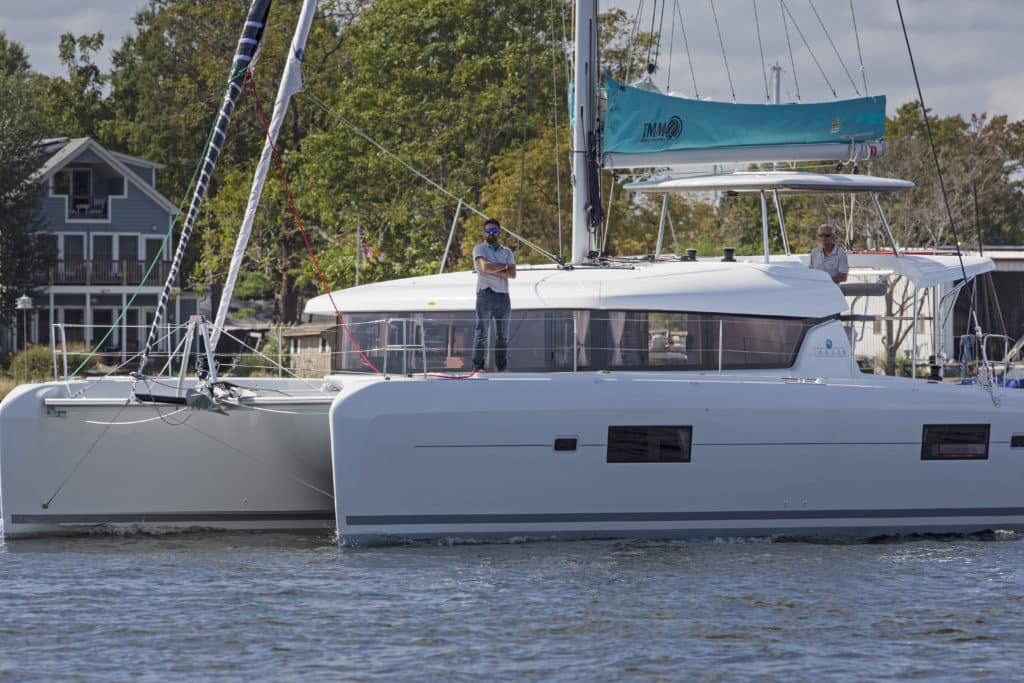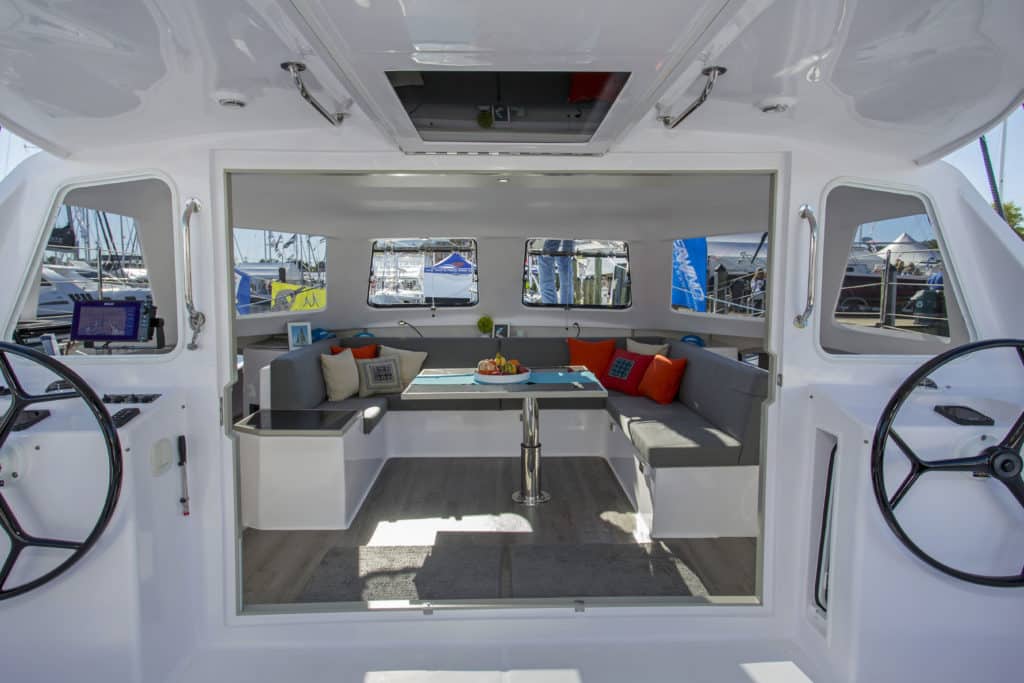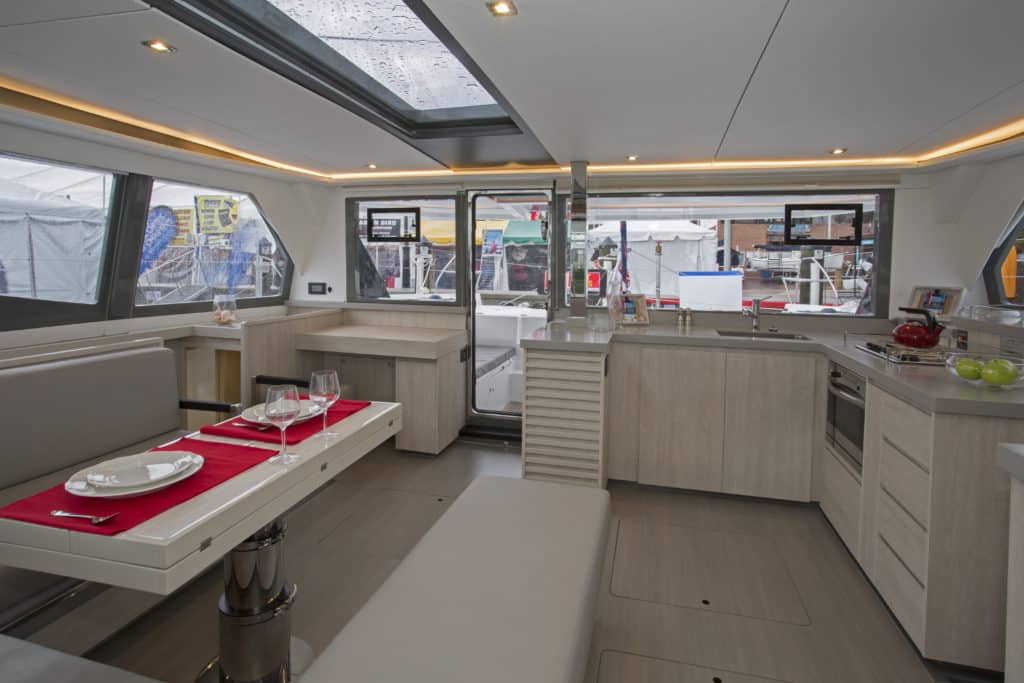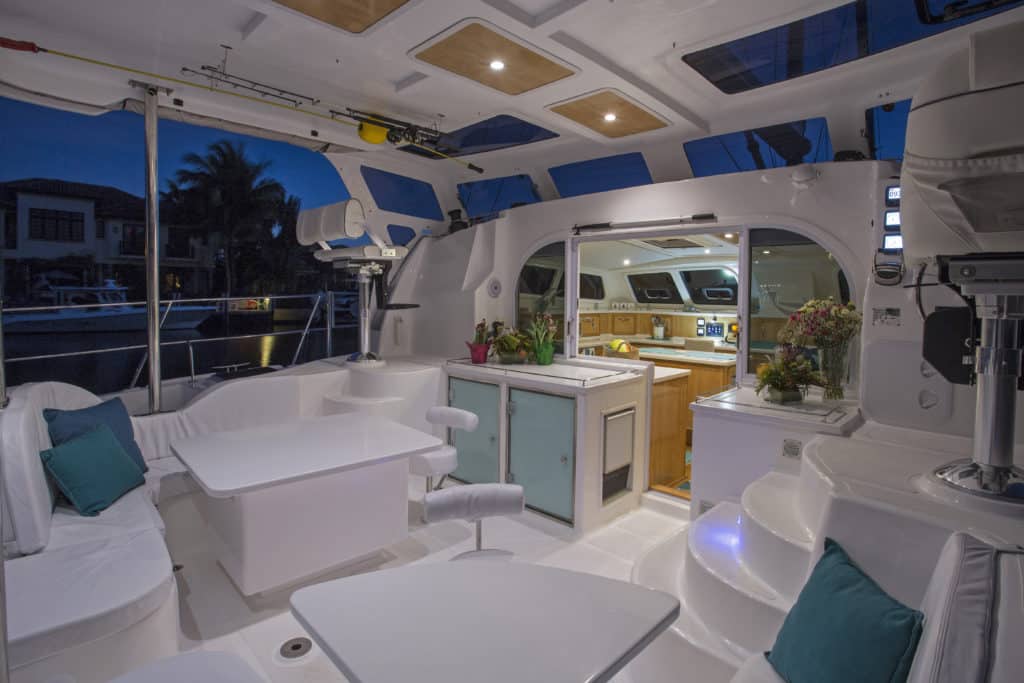
It was in the mid-1990s that cruising catamarans truly began to populate the waterfront. It’s not that cats didn’t exist before that; they just weren’t being produced in the significant numbers we’ve seen in the past 20 years. At last fall’s Annapolis boat show, catamarans represented fully half of the new models in Cruising World’s 2017 Boat of the Year event, and at least three builders of those cats launch hundreds of new boats every year.
If you’ve been watching this trend, as we have, you’ll recall that the layouts on earlier cruising cats hardly varied at all. Galley up, or galley down? After that choice, most cats followed a familiar pattern: helm to starboard at the coachroof bulkhead, mixed social and working cockpit, interior saloon on the bridgedeck, and berths and heads — and sometimes galleys — down in the hulls.
Today’s generation offers a far more sweeping range of layout choices.
Traditionalists
You can still find traditional layouts among today’s offerings. This year’s St. Francis 50 MK II, built in South Africa, is a vinylester-infused version of the Angelo Lavranos design that won Best Cruising Catamaran in CW’s 2006 BOTY contest. Like her earlier sibling, the MK II version features a mixed social and working cockpit under a hardtop in the aft half of the bridgedeck. In keeping with those previous designs, the genoa winch and rope clutch you’d use on starboard tack are mounted on the coachroof to port. This design minimizes sheet friction but either requires two people for every maneuver or singlehanders to quickly scurry from starboard to port and back — including two steps down from the helm seat and a big step up onto the cockpit settee or side deck. Folks lounging at the spacious outdoor table enjoy thorough protection from the weather but scant visibility forward.
The Royal Cape Majestic 530, a vacuum-bagged balsa-cored boat built in Durban, South Africa, exhibits a similar layout but at an exaggerated scale, offering the greatest headroom under the cockpit’s hard dodger of any boat in the 2017 fleet. There’s a trade-off here between significant weight aloft (a bad thing) and access to the full boom length when you stand on the hardtop (a good thing). As on the St. Francis, the genoa sheet leads to the port side for starboard tack. Promising comfortable cruising, company director Ken Bircher said, “I don’t pretend to be a high-performance builder,” and he estimates a typical day’s run for the boat at 150 nautical miles. This is one of the rare builders that still offers a galley-down interior, and the only to offer that along with five cabins and five separate heads.
The Seawind 1190 Sport applies the bulkhead-mounted helm — in this case, twin helms to port and starboard — to entirely different purposes. This speedy 39-footer, built in Vietnam by an Australian company, courts coastal sailors far more interested in minutes per mile than miles per day. With daggerboards raised, rudders lifted from their cartridges and twin 20 hp Honda outboard motors tilted up, her lithe hulls float in 22 inches of water. Just one installed head keeps weight down, and an athwartship queen berth keeps the hulls narrow. With sailhandling controls to port and starboard, the 1190’s smaller scale simplifies maneuvers for shorthanded cruising, and you can always position yourself to see the sails. In light air, our boat speed nearly matched the true wind speed of less than 5 knots. This Seawind earned the BOTY Judges’ Special Prize for 2017.

The Flybridge and the Sport Top
Back in 2004, Lagoon pioneered the flybridge concept with its 440 model. Since then, cat designers have become ever more deliberate about either mixing or blending outdoor social spaces and working spaces — sometimes entirely separating line handling and helm stations from dinettes and settees, sometimes clearly linking them. For every boat in this category, all sailhandling controls are brought to a single location, eliminating the athwartship dash during shorthanded maneuvers but sometimes adding the friction of additional sheet-lead turns.
Though we’ve seen many flybridge models in the past dozen years, our only example in this year’s fleet was the Bavaria Nautitech Fly 46. The French Nautitech line had been building boats for 20 years in La Rochelle when it was purchased in 2014 by Bavaria Yachtbau, a German high-production builder of monohulls. This flybridge 46-footer provides a sheltered outdoor social area on the aft bridgedeck that’s entirely separated from the running of the boat. Guests looking for sun and wind can move to sun pads on the foredeck or join the action up on the flybridge. The higher weight and center of effort of this design may limit the boat’s seagoing appeal, but for charters or parties it’s hard to beat.
In the meantime, some cat builders have adopted a hybrid layout that falls between the traditional bulkhead-mounted helm and the flybridge. Lagoon calls its version a SporTop, which accounts for the “S” in the Lagoon 450 S model name. In the case of the 450, the helm is up four steps from the sole, through a cutout in a hardtop over the aft deck. A smaller, separate hardtop, providing shelter for two, is raised on posts over the helm. Bending over, you can still make eye contact and speak with guests on the aft deck; there’s separation, but not as complete as that on a flybridge.
The Lagoon 42, judged Best Full-Size Multihull Under 50 Feet, also features a sport top, this one to port. What distinguishes this boat is that the rig has been moved aft substantially, providing for a much larger self-tacking genoa whose track runs athwart the cabin top.
Last year, Fountaine Pajot brought a flybridge model, the Ipanema 58, which won the 2016 award for Best Charter Boat. The year’s newest model, the Fountaine Pajot Lucia 40, features a sport-top helm to starboard and a well-protected social cockpit under the hardtop aft.

The Open Plan
Two virtues are exhibited in all the boats in the following group: exemplary sight lines throughout the boat, and a deliberate uniting of inside and outside spaces.
The Leopard 45, built by Robertson and Caine in Cape Town, South Africa, features a hybrid, or sport-top, helm station like those in the last category. But we include it here among the “open-plan” cats because it exemplifies the type. Her creators have gone to extraordinary measures to create a cat that sailors can both see and walk through from stern to stem. (Naval architect Alex Simonis created structural composite stringers underneath the bridgedeck that wrap into each hull to replace a crossbeam that would carry rig loads under the mast in most catamarans.) Seated in the aft cockpit, you can see forward directly through ½-inch Lexan windows and a frameless forward door to the horizon ahead; this is a thoroughly different experience from a view of white fiberglass. The Leopard 45 had the most developed forward cockpit of the 2017 fleet, and a helm station very well-organized for singlehanding. Together, they earned the cat the award for Best Charter Catamaran of 2017.
The Bali 4.0 Lounge, built by Catana in France and destined for Dream Yachts charter fleets, develops an indoor/outdoor idea Bali introduced last year. In this case, the entire bridgedeck is a single space containing the galley, dinette and nav station. A garage-door-style enclosure either opens the entire aft end to the weather or closes it off. Nonskid in the bridgedeck telegraphs its outdoor intentions. A flybridge helm and a full forward cockpit provide second and third outdoor social spaces.
BOTY judges deemed the Balance 526, built by Nexus Yachts in South Africa, the most successful cat in the fleet — and gave it the overall prize for Best Import Boat of the Year. Her open plan provides exemplary sight lines through tempered-glass windows from the aft deck as well as the saloon. The designer put this visibility to practical use with the boat’s Versahelm, a wheel on an articulating pedestal that allows the operator to steer from the sole level, fully protected from the weather, or from a raised position above the cabin top, providing uncluttered views of the sails as well as all four corners of the cat. The top-quality vacuum-bagged epoxy structure, featuring Corecell foam and E-glass with carbon reinforcements, is stiff and light. With slender hulls, clean lines and an ample sail plan, this Balance looks poised to tick off 250-mile days in comfort.

The Innovators
Two boats stood out for their innovation. The U.S.-built Maine Cat 38 uses a heat-and-pressure method called thermoforming to shape the sandwich laminate into complex curves without requiring cuts, or kerfs, that fill with resin and add weight. Creator Dick Vermeulen’s definition of success? “It has to be the fastest cruising cat on the water,” he said. While we haven’t had the chance to sail the boat, its integrity of purpose was clear at the dock. All accommodations — galley, head, berths — are down in the hulls. The bridgedeck is a single space under a hardtop, with the inside helm installed on centerline and nearly all sailhandling controls brought to a central space.
And finally, alone among all the cats we saw this year, the 37-foot, U.S.-built Gemini Freestyle offers no overnight accommodations whatsoever. Targeted at resorts — the first buyer is in Cancun — the Freestyle is intended as a great party platform for day trips, with sun protection under a hardtop and full exposure before the mast. The hull comes with the option to install either one or two heads. After years of seeing cookie-cutter consensus among the creators of cruising cats, it was refreshing in 2017 to see such a wide world of choices.
• • •
Tim Murphy is a CW editor-at-large and a longtime Boat of the Year judge.








